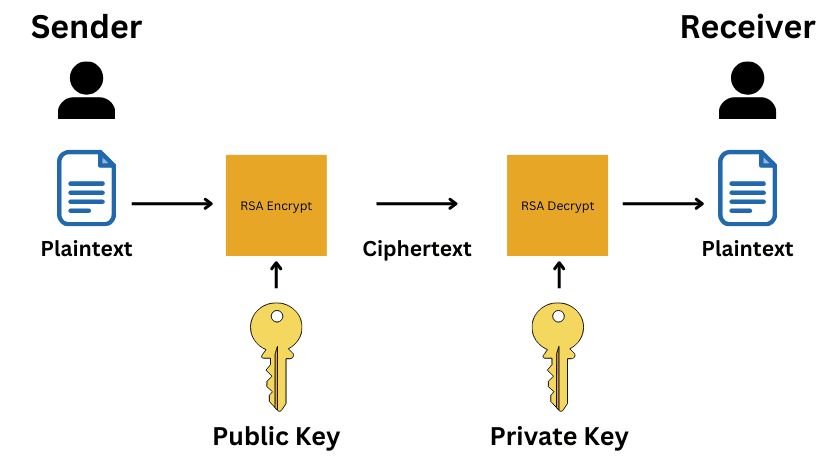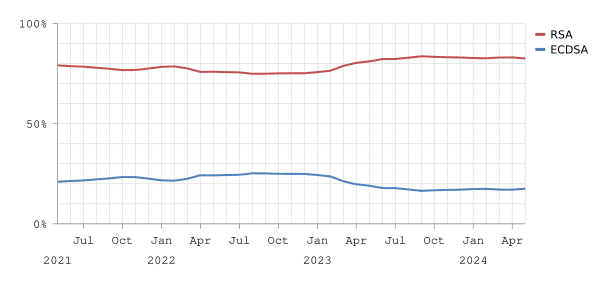N
Netcraft
Guest
FreeBSD, The FreeBSD Foundation, and The FreeBSD Forums are not associated with the content of this article.
On Monday 6th May, Netcraft will be heading to San Francisco along with thousands of other cyber security professionals for RSA Conference 2024. If you’re attending too, we thought we’d share a few insights into how it all started. Use them in line for coffee or at an evening event to show off your extensive knowledge of asymmetric cryptography algorithms (that’s a mouth full). If you’re at the event and would like to say hello, visit us at booth 362 in the South Expo Hall or register here and we’ll reach out.
RSA is one of the oldest encryption algorithms that is still widely used today for secure data transmission. It was originally published in 1977 and is classed as a public-key or asymmetric cryptography algorithm meaning it has two separate keys, one to encrypt data and a different one to decrypt. If two parties want to talk, each party can send the other party a public encryption key that they can use to encrypt messages they wish to send. They can both keep their decryption key private, making it a secure way of sending secret messages.

A diagram showing the asymmetric cryptography technique used by the RSA algorithm.
RSA however, is a relatively slow algorithm and so is not commonly used to directly encrypt user data. Instead, it can be used to transmit keys for symmetric cryptography, a class of encryption algorithm where the same key is used to both encrypt and decrypt the data. The symmetric algorithm is usually much faster and used for bulk encryption and decryption of the data. This use of RSA is one of the methods that can be used in TLS which is widely known for authenticating and securing connections across the internet such as in browsers, mobile apps and even over-the-air updates for cars.
RSA is also still the most common type of public key used for SSL certificates with substantially more utilisation than Elliptic Curve Digital Signature Algorithm (ECDSA) which provides increased security and performance over RSA at much smaller key sizes.

Graph showing utilisation of RSA compared to ECDSA from Netcraft’s SSL Survey Data.
The name “RSA” comes from the surnames of Ron Rivest, Adi Shamir and Leonard Adleman, who as well as originally publishing the algorithm also co-founded RSA Security in 1982, an American computer and network security company with a focus on encryption and encryption standards.
11 years later in 1991, Jim Bidzos, the CEO of RSA Security at the time, founded a small cryptography conference which he named the RSA Conference. The first conference had just one panel focusing on why attendees should not adopt DSS, a new standard that was up against RSA Security’s status as the de facto standard for digital signatures.
2 years later in 1993, RSA Conference attracted around 200 attendees and continued to rise each year, with about 40,000 cybersecurity professionals attending in 2023. This includes over 650 speakers and 500 exhibitors.
If you are around, stop by booth 362 in the South Expo Hall and see us for a chat and to pick up swag highlighting some of Netcraft’s most valued customers. We’d love to set up time to meet with you or your team in person and give you a look behind the curtain at some of Netcraft’s upcoming product developments and innovations.
If you’d like to book time to meet with us, simply visit this page, add your email and we’ll reach out. If you’d just like to stop by, we’d love to meet with you at booth 362 in the South Expo Hall.
Now you can impress your colleagues with your knowledge on the history of RSA and for everyone attending, we hope you enjoy your time in the city by the bay!
On Monday 6th May, Netcraft will be heading to San Francisco along with thousands of other cyber security professionals for RSA Conference 2024. If you’re attending too, we thought we’d share a few insights into how it all started. Use them in line for coffee or at an evening event to show off your extensive knowledge of asymmetric cryptography algorithms (that’s a mouth full). If you’re at the event and would like to say hello, visit us at booth 362 in the South Expo Hall or register here and we’ll reach out.
RSA is one of the oldest encryption algorithms that is still widely used today for secure data transmission. It was originally published in 1977 and is classed as a public-key or asymmetric cryptography algorithm meaning it has two separate keys, one to encrypt data and a different one to decrypt. If two parties want to talk, each party can send the other party a public encryption key that they can use to encrypt messages they wish to send. They can both keep their decryption key private, making it a secure way of sending secret messages.

A diagram showing the asymmetric cryptography technique used by the RSA algorithm.
RSA however, is a relatively slow algorithm and so is not commonly used to directly encrypt user data. Instead, it can be used to transmit keys for symmetric cryptography, a class of encryption algorithm where the same key is used to both encrypt and decrypt the data. The symmetric algorithm is usually much faster and used for bulk encryption and decryption of the data. This use of RSA is one of the methods that can be used in TLS which is widely known for authenticating and securing connections across the internet such as in browsers, mobile apps and even over-the-air updates for cars.
RSA is also still the most common type of public key used for SSL certificates with substantially more utilisation than Elliptic Curve Digital Signature Algorithm (ECDSA) which provides increased security and performance over RSA at much smaller key sizes.

Graph showing utilisation of RSA compared to ECDSA from Netcraft’s SSL Survey Data.
The name “RSA” comes from the surnames of Ron Rivest, Adi Shamir and Leonard Adleman, who as well as originally publishing the algorithm also co-founded RSA Security in 1982, an American computer and network security company with a focus on encryption and encryption standards.
11 years later in 1991, Jim Bidzos, the CEO of RSA Security at the time, founded a small cryptography conference which he named the RSA Conference. The first conference had just one panel focusing on why attendees should not adopt DSS, a new standard that was up against RSA Security’s status as the de facto standard for digital signatures.
2 years later in 1993, RSA Conference attracted around 200 attendees and continued to rise each year, with about 40,000 cybersecurity professionals attending in 2023. This includes over 650 speakers and 500 exhibitors.
Meet Netcraft at RSAC
If you are around, stop by booth 362 in the South Expo Hall and see us for a chat and to pick up swag highlighting some of Netcraft’s most valued customers. We’d love to set up time to meet with you or your team in person and give you a look behind the curtain at some of Netcraft’s upcoming product developments and innovations.
If you’d like to book time to meet with us, simply visit this page, add your email and we’ll reach out. If you’d just like to stop by, we’d love to meet with you at booth 362 in the South Expo Hall.
Now you can impress your colleagues with your knowledge on the history of RSA and for everyone attending, we hope you enjoy your time in the city by the bay!

